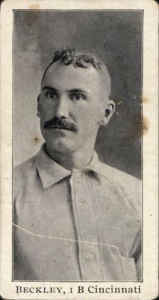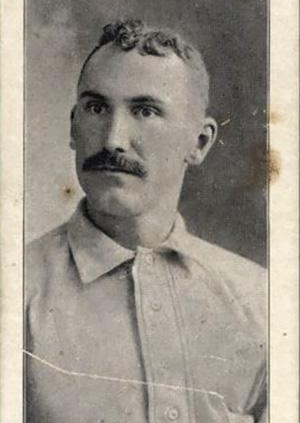May 13, 1902: Phillies led to 24-2 slaughter by Reds
 Cincinnati has long prided itself as the cradle of America’s national pastime. The Reds were founded in 1866 and were the first openly professional team in 1869, and the city’s love affair with baseball in general and the Reds in particular is unmatched in the annals of the game.
Cincinnati has long prided itself as the cradle of America’s national pastime. The Reds were founded in 1866 and were the first openly professional team in 1869, and the city’s love affair with baseball in general and the Reds in particular is unmatched in the annals of the game.
But that faith was being tested in 1902, as Cincinnati was coming off its first last-place finish ever in 1901, just 52-87 in the National League, 38 games out of first.
And despite the mediocre results on the diamond – the Reds would finish at 70-70 in fourth place in 1902 – the club unveiled a remodeled park dubbed the Palace of the Fans.
It was unlike any ballpark before or since. The façade of the grandstand was a blend of Roman and Greek styling with 22 hand-carved Corinthian columns. The grandstand sat atop carriage stalls, basically parking spots for horse-drawn wagons, so the well-off could literally drive to the game.1
The 3,000-seat grandstand featured 19 “fashion boxes” along the front railing that could hold a dozen or so fans. These were designed to mimic the extravagant private boxes one would find at a high-end theater or opera house. Beneath the grandstand, at field level, was standing room for 640 more spectators in a loud and raucous section known as Rooters Row.2
The Palace of the Fans opened April 17, 1902, Opening Day, to a crowd estimated at 10,000.
But despite the deep baseball roots and the fancy new ballpark, the team’s performance on the field hurt attendance. Less than a month later, for this mid-May slaughter, only 400 fans were present.
“It had rained a half-hour before play began and only the faithful were there to make up a little family tea party,” said the next day’s Cincinnati Enquirer.3
They saw a record performance from the home team, a 24-2 thrashing of the Philadelphia Phillies. The 24 runs were the most by a Reds team until they scored 26 against Boston on June 4, 1911. The 28 hits still stand as the most by the Reds in a game, although the mark was equaled on May 19, 1999, at Colorado.
After Cincinnati starting pitcher Bill Phillips retired the Phillies in the top of first, the carnage began. After Cincinnati’s leadoff man, William “Dummy” Hoy (so nicknamed because he was deaf), was retired, Harry Bay reached when his short fly fell in front of Philadelphia left fielder George Browne.
Future Hall of Famer Jake Beckley singled and took second when the throw to get Bay at third was late. Another future Hall of Famer, Sam Crawford, singled both runners home. After George “Maggie” Magoon wrangled a walk from Phillies starter Doc White, Crawford stole third. With runners at the corners, Tommy Corcoran bounced to Pete Childs at second, who booted the ball, allowing Crawford to score and make it 3-0. It was the first of seven Philadelphia errors.
Harry Steinfeldt followed with a single scoring Magoon for a 4-0 lead, and Phillies manager Bill Shettsline removed White. Cy Vorhees relieved and fared little better.
Heinie Peitz, the Reds catcher, tripled to right, scoring two more for a 6-0 lead. Phillips, the Reds pitcher, singled to score Peitz. Hoy walked and Bay reached on a bunt single to fill the bases. Beckley also bunted and Vorhees couldn’t handle it, as the eighth run scored on the error.
The Enquirer noted, “Cincinnati scored more runs in that first inning yesterday than they have done in 18 of the games they have played this season.”4
They were just getting warmed up. Sporting Life (a contemporary weekly of The Sporting News) related, “The Cincinnati field is the roughest in the League. Visiting teams say that it is not to be wondered at that the Reds make so many errors.”5 The comment was borne out in this game as the Phillies made seven errors, the Reds three. Despite that, the Sporting Life box score credits 22 of the 24 Cincinnati runs as earned.
The Phillies scratched out two runs in the third, but Vorhees was knocked out in the fourth as Cincinnati scored four times, the big hits being a double by Corcoran and a triple by pitcher Phillips. Harry Felix relieved Vorhees and surrendered three runs in the fifth and two more in the sixth, a 17-2 deficit.
The Reds batted around in the eighth, scoring seven more runs. Beckley singled twice, and the Reds got singles from Hoy and Corcoran, doubles from Magoon and Peitz, a triple from Crawford and a home run to extreme right field by Steinfeldt. It was Steinfeldt’s only homer of the season for a team that hit just 18. The papers noted the time of the game at two hours.
Every Cincinnati player had at least two hits and only Hoy, the leadoff man, didn’t score a run. Pitcher Bill Phillips went the distance, allowing two runs on eight hits with a walk and a strikeout. He himself had four hits, including his triple. This was a bit of redemption for Phillips, as the Phillies had pounded him for all 19 runs in a 19-1 defeat on June 24, 1901.
“Gracious, how they did hit!” said Klondike Bill Douglass [first baseman for the Phillies in the game] last night. “There was no stopping them.”6
Beckley, Corcoran, and Phillips each had four hits. Bay, Crawford, Steinfeldt, and Peitz added three apiece.
The Phillies suffered two casualties. After his first-inning error, Childs “was taken ill and forced to retire in the second.”7 And in the fifth, “Roy Thomas was called out on strikes but objected so noisily that Umpire Powers benched him.”8 The score was 12-2 at the time.
The big victory did not inspire the Reds: They continued to stumble, eventually landing in last place. Manager Bid McPhee, another future Hall of Famer and one of the greatest Reds of the nineteenth century, resigned in mid-July amid rumors that he was about to be replaced by yet another future Hall of Famer, Joe Kelley, then with Baltimore. Kelley eventually did take over, and the Reds showed marked improvement in the season’s second half, finishing fourth with a record of 70-70.
Shettsline’s Phillies went nowhere. He nudged them up to fourth place briefly in June but by the end of July, they were in seventh place, where they remained for the rest of the season.
Notes
1 Philip J. Lowry, Green Cathedrals (Reading, Massachusetts: Addison-Wesley, 1992), 137.
2 Lowry, 137.
3 Cincinnati Enquirer, May 14, 1902.
4 Cincinnati Enquirer, May 14, 1902.
5 “National League, Games Played Tuesday, May 13,” Sporting Life, May 24, 1902: 10.
6 Cincinnati Enquirer, May 14, 1902.
7 Sporting Life, May 24, 1902.
8 Philadelphia Times, May 14, 1902.
Additional Stats
Cincinnati Reds 24
Philadelphia Phillies 2
Palace of the Fans
Cincinnati, OH
Box Score + PBP:
Corrections? Additions?
If you can help us improve this game story, contact us.


